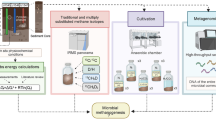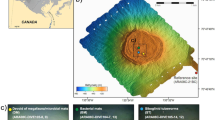Abstract
Mud volcanism is an important natural source of the greenhouse gas methane to the hydrosphere and atmosphere1,2. Recent investigations show that the number of active submarine mud volcanoes might be much higher than anticipated (for example, see refs 3–5), and that gas emitted from deep-sea seeps might reach the upper mixed ocean6,7,8. Unfortunately, global methane emission from active submarine mud volcanoes cannot be quantified because their number and gas release are unknown9. It is also unclear how efficiently methane-oxidizing microorganisms remove methane. Here we investigate the methane-emitting Haakon Mosby Mud Volcano (HMMV, Barents Sea, 72° N, 14° 44′ E; 1,250 m water depth) to provide quantitative estimates of the in situ composition, distribution and activity of methanotrophs in relation to gas emission. The HMMV hosts three key communities: aerobic methanotrophic bacteria (Methylococcales), anaerobic methanotrophic archaea (ANME-2) thriving below siboglinid tubeworms, and a previously undescribed clade of archaea (ANME-3) associated with bacterial mats. We found that the upward flow of sulphate- and oxygen-free mud volcano fluids restricts the availability of these electron acceptors for methane oxidation, and hence the habitat range of methanotrophs. This mechanism limits the capacity of the microbial methane filter at active marine mud volcanoes to <40% of the total flux.
This is a preview of subscription content, access via your institution
Access options
Subscribe to this journal
Receive 51 print issues and online access
$199.00 per year
only $3.90 per issue
Buy this article
- Purchase on Springer Link
- Instant access to full article PDF
Prices may be subject to local taxes which are calculated during checkout



Similar content being viewed by others
References
Kopf, A. J. Significance of mud volcanism. Rev. Geophys. B 40, 1–49 (2002)
Milkov, A. V. et al. Global gas flux from mud volcanoes: A significant source of fossil methane in the atmosphere and the ocean. Geophys. Res. Lett. 30, doi:10.1029/2002GL016358. (2003)
Bohrmann, G. et al. Mud volcanoes and gas hydrates in the Black Sea: new data from Dvurechenskii and Odessa mud volcanoes. Geo-Mar. Lett. 23, 239–249 (2003)
Pinheiro, L. M. et al. Mud volcanism in the Gulf of Cadiz: results from the TTR-10 cruise. Mar. Geol. 195, 131–151 (2003)
Loncke, L. et al. Mud volcanoes, gas chimneys, pockmarks and mounds in the Nile deep-sea fan (Eastern Mediterranean): geophysical evidences. Marine Petrol. Geol. 21, 669–689 (2004)
MacDonald, I. R. et al. Transfer of hydrocarbons from natural seeps to the water column and atmosphere. Geofluids 2, 95–107 (2002)
Rehder, G. et al. Enhanced lifetime of methane bubble streams within the deep ocean. Geophys. Res. Lett. 29, 21–24 (2002)
Sauter, E. J. et al. Methane discharge from a deep-sea submarine mud volcano into the upper water column by gas hydrate-coated methane bubbles. Earth Planet. Sci. Lett. 243, 354–365 (2006)
Vogt, P. R. et al. Haakon Mosby mud volcano: A warm methane seep with seafloor hydrates and chemosynthesis-based Ecosystem in late Quarternary Slide Valley, Bear Island Fan, Barents Sea passive margin. EOS Trans. AGU 78, 187–189 (1997)
Vogt, P. R., Gardner, J. & Crane, K. The Norwegian-Barents-Svalbard (NBS) continental margin: Introducing a natural laboratory of mass wasting, hydrates, and ascent of sediment, pore water, and methane. Geo-Mar. Lett. 19, 2–21 (1999)
Ginsburg, G. D. et al. Gas hydrate accumulation at the Håkon Mosby Mud Volcano. Geo-Mar. Lett. 19, 57–67 (1999)
Damm, E. & Budéus, G. Fate of vent-derived methane in seawater above the Håkon Mosby mud volcano (Norwegian Sea). Mar. Chem. 82, 1–11 (2003)
Milkov, A. V. et al. Geological, geochemical, and microbial processes at the hydrate-bearing Håkon Mosby mud volcano: a review. Chem. Geol. 205, 347–366 (2004)
Kaul, N., Foucher, J. P. & Heesemann, M. Estimating mud expulsion rates from temperature measurements on Håkon Mosby Mud Volcano, SW Barents Sea. Mar. Geol. 229, 1–14 (2006)
de Beer, D. et al. In situ fluxes and zonation of microbial activity in surface sediments of the Håkon Mosby Mud Volcano. Limnol. Oceanogr. 51, 1315–1331 (2006)
Jerosch, K. et al. Spatial distribution of mud flows, chemoautotrophic communities, and biogeochemical habitats at Håkon Mosby Mud Volcano. Mar. Geol. (submitted).
Distel, D. L., Lee, H. K. W. & Cavanaugh, C. M. Intracellular coexistence of methanotrophic and thioautotrophic bacteria in a hydrothermal vent mussel. Proc. Natl Acad. Sci. USA 92, 9598–9602 (1995)
Knittel, K. et al. Activity, distribution, and diversity of sulfate reducers and other bacteria in sediments above gas hydrate (Cascadia margin, Oregon). Geomicrobiol. J. 20, 269–294 (2003)
Orphan, V. J. et al. Comparative analysis of methane-oxidizing archaea and sulfate- reducing bacteria in anoxic marine sediments. Appl. Environ. Microbiol. 67, 1922–1934 (2001)
Knittel, K. et al. Diversity and distribution of methanotrophic archaea at cold seeps. Appl. Environ. Microbiol. 71, 467–479 (2005)
Boetius, A. et al. A marine microbial consortium apparently mediating anaerobic oxidation of methane. Nature 407, 623–626 (2000)
Niemann, H. et al. Methane emission and consumption at a North Sea gas seep (Tommeliten area). Biogeosciences 2, 335–351 (2005)
Hinrichs, K-U. & Boetius, A. in Ocean Margin Systems (eds Wefer, G., Billett, D. & Hebbeln, D.) 457–477 (Springer, Berlin, 2002)
Reeburgh, W. S. in Treatise on Geochemistry Vol. 4 (ed. Keeling, R. F.) 65–89 (Elsevier–Pergamon, Oxford, 2003)
Treude, T. et al. Anaerobic oxidation of methane above gas hydrates at Hydrate Ridge, NE Pacific Ocean. Mar. Ecol. Prog. Ser. 264, 1–14 (2003)
Sibuet, M. & Olu, K. Biogeography, biodiversity and fluid dependence of deep-sea cold-seep communities at active and passive margins. Deep-Sea Res. II 45, 517–567 (1998)
Judd, A. G. et al. The geological methane budget at Continental Margins and its influence on climate change. Geofluids 2, 109–126 (2002)
Luff, R. & Wallmann, K. Fluid flow, methane fluxes, carbonate precipitation and biogeochemical turnover in gas hydrate-bearing sediments at Hydrate Ridge, Cascadia Margin: Numerical modeling and mass balances. Geochim. Cosmochim. Acta 67, 3403–3421 (2003)
Brown, K. M. et al. Correlated transient fluid pulsing and seismic tremor in the Costa Rica subduction zone. Earth Planet. Sci. Lett. 238, 189–203 (2005)
Elvert, M. et al. Characterization of specific membrane fatty acids as chemotaxonomic markers for sulfate-reducing bacteria involved in anaerobic oxidation of methane. Geomicrobiol. J. 20, 403–419 (2003)
Acknowledgements
The expeditions ‘AWI’ on RV L’Atalante in 2001 and ‘ARK XIX3b’ on RV Polarstern in 2003, both with ROV Victor 6000, were jointly planned, coordinated and carried out by the Alfred Wegener Institute for Polar and Marine Research in Bremerhaven, Germany, and the French Research Institute for Exploitation of the Sea (IFREMER) in Brest, France. We thank the captain and crew, the team of the ROV Victor 6000 and the shipboard scientific community of the RV Polarstern and L’Atalante for their help at sea. We thank S. Lüdeling, L. Baumann, V. Beier, I. Busse, F. Heinrich, G. Eickert, A. Nordhausen, J. Rogenhagen and R. Usbeck for technical assistance, C. Edy for help with georeferencing, U. Witte for providing the benthic lander technology, and S. Joye for comments on the manuscript. This is publication no. GEOTECH-235 of the R&D-Programme GEOTECHNOLOGIEN, Project MUMM, funded by the German Ministry of Education and Research (BMBF) and German Research Foundation (DFG). Author Contributions T.L., T.N., K.K. and R.A. carried out the 16S-rRNA-based analyses and microscopy, H.N. and M.E. the lipid biomarker work, A.B. and H.N. the rate measurements, D.B., E.S. and M.S. the microsensor and geochemical measurements, and M.K., M.S., A.B., H.N. and J.P.F. the geo- and video-graphical survey and experimental strategy. A.B., H.N. and D.B. wrote the manuscript text, and H.N., T.L. and K.K. wrote the supplements. All authors discussed the results and commented on the manuscript.
Author information
Authors and Affiliations
Corresponding author
Ethics declarations
Competing interests
The nucleotide sequence data have been deposited in EMBL, GenBank and the DDBJ nucleotide sequence database under accession numbers AJ704650–AJ704653, AJ704631 and AM287206–AM287207. Reprints and permissions information is available at www.nature.com/reprints. The authors declare no competing financial interests.
Supplementary information
Supplementary Notes
This file includes a section about the methane budget, the identity of the different methanotrophic communities as determined by 16S rDNA analysis, fluorescence in situ hybridisation (FISH) and lipid biomarker patterns. This file also contains Supplementary Methods and Supplementary Figure Legends. (DOC 60 kb)
Supplementary Figure 1
This file contains the phylogenetic tree of archaeal 16S rDNA sequences of Haakon Mosby mud volcano. (PDF 155 kb)
Supplementary Figure 2
This file contains the phylogenetic tree of bacterial 16S rDNA sequences of Haakon Mosby mud volcano. (PDF 164 kb)
Rights and permissions
About this article
Cite this article
Niemann, H., Lösekann, T., de Beer, D. et al. Novel microbial communities of the Haakon Mosby mud volcano and their role as a methane sink. Nature 443, 854–858 (2006). https://doi.org/10.1038/nature05227
Received:
Accepted:
Issue Date:
DOI: https://doi.org/10.1038/nature05227
This article is cited by
-
Water Ice and Possible Habitability in the Landing Area of Tianwen-1 Mission
Space Science Reviews (2024)
-
Bacterial symbiont diversity in Arctic seep Oligobrachia siboglinids
Animal Microbiome (2023)
-
Evidence of Arctic methane emissions across the mid-Pleistocene
Communications Earth & Environment (2023)
-
Water column dynamics control nitrite-dependent anaerobic methane oxidation by Candidatus “Methylomirabilis” in stratified lake basins
The ISME Journal (2023)
-
Studies on biodiversity and bioprospecting of active mud volcano associated bacteria and actinobacteria from Baratang, Andaman Islands, India
Systems Microbiology and Biomanufacturing (2023)
Comments
By submitting a comment you agree to abide by our Terms and Community Guidelines. If you find something abusive or that does not comply with our terms or guidelines please flag it as inappropriate.



